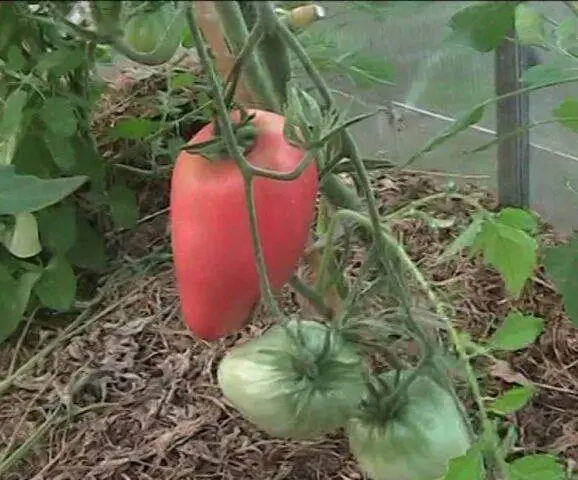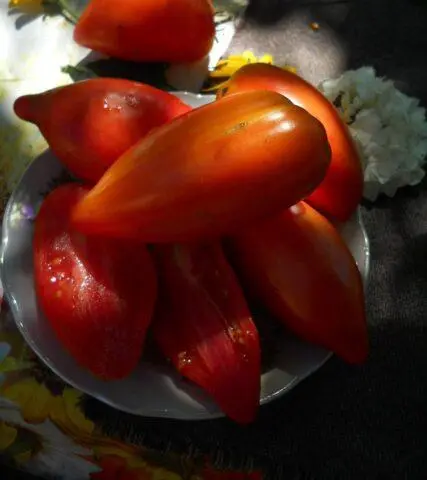Contents
Cow’s ears tomato is a variety of selection, bred more than 10 years ago. It is grown in garden beds and greenhouses. The fruits have a very pleasant taste. The pulp is juicy and fleshy, gives a pleasant fruity aroma. Bushes require some care – garters, shaping, regular watering. The yield is average, so the variety is grown for personal purposes.
History of breeding
Tomato Cow’s ears (also Cow’s ear) is a variety of selection, bred by Kondakov S.N. and Kotelnikova M.A. The originators are: LLC Agrofirm “Seeds of Altai” and IP Kondakov Sergey Nikolaevich.
An application for admission to the register of breeding achievements of the Federation was submitted in 2007, registration took place in 2010. The variety is recommended for cultivation in most regions, including:
- middle lane;
- the Volga region;
- Chernozem region;
- southern regions;
- Northwest;
- The Urals;
- Western and Eastern Siberia;
- Far East.
Description of the variety of tomato Ox ears
Cow’s Ears is a cultivar, not a hybrid. You can independently collect seeds and grow full-fledged offspring from them.
In the description of the tomato variety Ox ear, the following characteristics are given:
- determinant (grows until a certain height is reached);
- undersized – an average of 60-80 cm, sometimes up to 100 cm;
- mid-season – from the moment of germination to technical ripeness, 110-120 days pass.
The leaves are medium in size, typical green in color. Inflorescences of a simple type, the peduncle has an articulation. Fruits of tomatoes Cow’s ears in an unripe state are green in color with a lighter spot at the base, as they ripen, they become bright red. The shape is cylindrical, elongated, there is a pointed tip, partly reminiscent of an ear, which is the reason for the name of the variety. The surface is glossy, shines in the sun, slightly ribbed.

On one brush ripens 4-6 tomatoes
Basically, the fruits weigh 100-110 g, in the greenhouse you can get larger specimens up to 150-200 g. Tomato pulp Ox ears of medium density, juicy, 4-6 seed nests are noticeable on the cut. Taste qualities are characterized as excellent, with sweetish tones and pleasant sourness. Ripe fruits have an interesting fruity flavor.
Characteristics of tomato Cow’s ears
Variety Ox ears is unpretentious, adapts well to different climatic conditions. Therefore, it can be grown not only in greenhouses and under film shelters, but also in open ground.
Tomato yield Cow’s ears
Variety Ox ears is characterized by moderate yield. From 1 m², you can collect an average of 6,3 kg of marketable fruits. When grown in a greenhouse, the figure increases slightly. The yield is also affected by weather conditions, soil composition and compliance with the rules of care.
Disease and pest resistance
Cow’s ears variety is relatively resistant to common diseases. However, it is not worth completely eliminating the risk of damage by late blight, various forms of rot. Therefore, after transplanting seedlings into the ground or greenhouse, fungicide treatment should be carried out. Also, plants are periodically inspected and, when insects appear, insecticides or a solution prepared on the basis of folk remedies are sprayed.
Ways to use
Ox ears tomatoes are most often used fresh – they are great for salads and other vegetable snacks. They go well with soups and main dishes, as well as for homemade preparations (tomato juice, mashed potatoes, vegetable caviar). Fruit sizes are medium and large, so they are rarely used for whole-fruit canning. For these purposes, you can take only relatively small tomatoes.
Advantages and disadvantages of tomato Cow’s ears
Summer residents appreciate Ox ears tomatoes for their very good taste. The fruits are attractive. They can be grown both for themselves and for sale.

The fruits are large, pleasant appearance and excellent taste
Pros:
- good binding;
- fast maturation;
- can be grown in most regions;
- seeds collected by hand are suitable for growing.
Cons:
- bushes need to be formed and tied up;
- frequent watering is required;
- average yield;
- fruits are generally not suitable for whole-fruit canning.
Peculiarities of growing
Cow’s ears tomato is grown in seedlings. Sowing seeds is planned for the first half of March or a little later, with the expectation that transplantation is carried out exactly two months after germination. The soil for planting is purchased in a store or made up independently on the basis of garden soil with the addition of compost (or humus), black peat and sand (2: 1: 1: 1), as well as a small pinch of wood ash. Previously, the earth is disinfected with a weak solution of potassium permanganate or sterilized in the oven (20 minutes at a temperature of 150 degrees).
Growing instructions are standard:
- Place the seeds in a 5% salt solution and discard those that float.
- Pickle them in a weak solution of potassium permanganate or any fungicide.
- Plant in common boxes or peat tablets to a depth of 1 cm (leave 4-5 cm between plantings).
- Spray with water from a spray bottle, cover with a film with holes and put in a warm place (temperature 24-25 degrees).
- After germination, remove the film.
- Dive after the formation of 2-3 true leaves.
- Feed “Kemira Lux”, “Ideal” or other complex fertilizer.
- 2 weeks before transplanting into the ground, start hardening the seedlings, taking them out onto the balcony or outside.

For growing seedlings, you can use different containers
Cow’s ears tomato seedlings are planted in the ground according to the 50×40 cm scheme in rows or in a checkerboard pattern so that at least four bushes fit on one square meter. Further care for them involves the following actions:
- Regular watering at least twice a week.
- Fertilization every 10-15 days (complex mineral and organic formulations).
- Periodic loosening of the soil and weeding.
- The formation of a bush in 2-3 stems.
- Carrying out pinching every 5-7 days.
- Tie to support.
Pest and disease control
To grow healthy tomatoes Cow’s ear, as in the photo, summer residents in the reviews recommend taking care of the prevention of diseases and pests. Main measures:
- frequent loosening of the soil;
- regular weeding;
- laying mulch (peat, straw, hay);
- treatment with fungicides (“Fitosporin”, “HOM”, “Ordan”, “Maxim” and others).
When spider mites, thrips, aphids and other pests of planting tomatoes appear, Cow’s ears should be treated with folk remedies (a solution of soda, ammonia, an infusion of tobacco dust, garlic, wood ash). In extreme cases, you need to use insecticides – “Biotlin”, “Fitoverm”, “Decis”, “Aktellik” and others.
To protect the plant, crushed chili peppers, egg shells or nuts are poured next to the garden bed, and traps are made.

Tomatoes are harvested at the end of July
Conclusion
Cow’s ears tomato is a relatively new, but already quite well-known variety. Summer residents speak of him extremely positively. Almost 100% of buyers recommend landing. Tomatoes are delicious, with a pleasant aroma, great for fresh consumption and for preparations.









